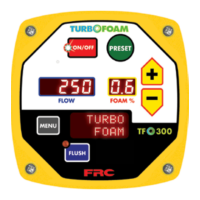TFC100 Rev180215
55
Saddle Clamp Installation
Note: Ensure that the mounting location meets the requirements for uniform water ow and that there
is enough room for the saddle clamp, sensor, and connector to t.
1. Drill and deburr a 1-11/16" to 1-3/4" diameter hole at mounting location.
2. Clean pipe surface in area where saddle clamp gasket seal.
Note: The sensor housing is epoxied in the saddle clamp with the alignment tab in the correct position
and is not meant to be removed.
3. Place saddle clamp over hole with sensor housing centered.
4. Tighten saddle clamp nuts until the gasket makes a good tight seal.
5. Insert ow sensor into sensor housing. Align at spot on sensor rim with alignment tab and make sure
O-ring is in groove.
Note: The retainer cap is hand-tightened. There is an inside lip that stops the cap from turning when
it makes contact with the alignment tab. This provides the correct pressure to make the seal at the
O-ring. Make sure the ow sensor engages the alignment tab and does not rotate.
6. Install retainer cap and hand tighten.
7. Connect ow sensor cable. (Refer to Wiring Section.)
Figure L12. Saddle Clamp Installation
Note: Dimensions are typical and are an aid
to determine ow sensor mounting locations.
Pipe Size Dimensions
(Sch 40) A B C
2 5.5 3.9 2.9
2.5 5.5 3.9 2.8
3 5.9 3.9 2.8
3.5 6.8 4.3 2.8
4 6.8 4.3 2.8
5 8 4.3 2.8
Measurements are in inches.
A
C
B
Retainer Cap
O-Ring
Paddlewheel
Flow Sensor
Sensor
Housing
Saddle
Clamp
Alignment Tab
Note: Allow a minimum of 3 inches clearance above
the sensor for removal/installation.
Note: When the retainer cap is tightened
make sure the ow sensor engages the
alignment tab and does not rotate.

